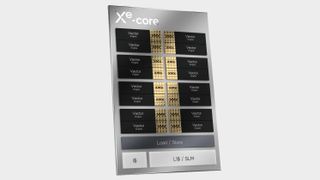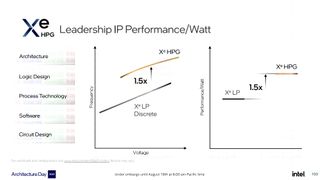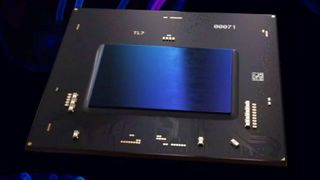Intel Xe Alchemist: Everything we know about Intel's gaming GPU
Intel Alchemist, previously known as DG2, could have an outside chance of competing with the best graphics cards around.

- Release date: Q1 2022
- Codename: Alchemist
- Architecture: Xe-HPG
- Process: TSMC 6nm (N6)
- Performance target: Nvidia GeForce RTX 3070 (rumoured)
Intel Alchemist, aka DG2, GPUs are set to become the first gaming graphics cards spun out of the Intel Xe-HPG yarn, something that is promised to be the basis for many more competitive GPUs from the chipmaking goliath. Alchemist also happens to be the first offering from Intel's high-performance graphics brand, Arc, which covers hardware, software and services. It's all set to kick-off at the start of next year, when we'll see Intel put its best foot forward in hopes to heave open the hydraulic grip of Nvidia and AMD over gaming GPUs.
There are two key battles in PC gaming hardware: Intel vs AMD and AMD vs Nvidia. It's been that way for millennia. Or a handful of decades, at least. Yet that could be all about to change with Intel Alchemist and the Xe-HPG architecture. Intel will be hoping to claim a stake of a market historically split between the red and green teams and with it a share of the mammoth profits on offer from gaming GPUs.
Intel isn't entirely a stranger to the GPU market, either, as it's one of the largest GPU makers in the world by sheer volume. All but a few Intel CPUs come with an integrated GPU, and while that won't mean all that much to gamers, that silicon actually forms the basis of Intel Xe-HPG, the architecture powering Intel's high-end gaming dreams.
Xe-HPG is born out of both Intel's Xe-LP and Xe-HPC architectures, but with some specialised twists. As Intel has since explained at its Architecture Day 2021, Xe-HPG is built for gaming first.
Even before we dive into the architecture, though, Intel's entry into the graphics game is a welcome one. As GPU prices rise, not the least bit more now that shortages are rampant, it's high time someone else gave AMD and Nvidia a run for their money.
Whether you're a potential customer, on the fence, or a diehard fan of the other guy, Intel Alchemist and Xe-HPG should get you excited like a kid at Christmas.
Specifications

Intel Alchemist specs
Intel Alchemist isn't a single graphics card, it's actually a range of graphics cards. We had expected a segmentation along the lines of Execution Units (EUs) and memory, although that isn't entirely accurate nowadays as Intel has shifted from the humble EU in favour of the new, all-encompassing Xe-core.
The biggest gaming news, reviews and hardware deals
Keep up to date with the most important stories and the best deals, as picked by the PC Gamer team.
The Xe-core is the new fundamental building block for Intel's gaming GPUs.
This doesn't entirely change things up, as both Xe-core and EU should share the same essential functionality of grouping together ALUs. However, the Xe-cores in Xe-HPG are not analogous with what came before, so our best laid plans for possible specifications are just slightly awry.
The new Xe-core within Alchemist GPUs features 16 Vector Engines and 16 Matrix Engines, which is actually double that found in Xe-HPC. Intel says this was a decision it made to put gaming first for its Alchemist GPUs, and was necessary to build out big gaming graphics cards.
So how many Xe-cores and Render Slices will be found within Alchemist GPUs? It's a good question, and so far we're still working with rumours based on the assumption these would be EUs.
Previous rumours (via a non-existent tweet from leaker Komachi_Ensaka) strongly suggested a 512 EU and 384 EU configuration out of Alchemist, which may still prove true if you simply switch out the phrase EU for Vector Engine.
If everything had remained the same between Xe-HPG and Xe-LP, the version found within Intel's current generation 11th Gen Tiger Lake mobile processors, then we could've expected the equivalent of a total of 4,096 FP32 cores within the 512 EU chip. That's one eight-wide ALU per EU, each capable of eight floating-point operations per clock.
With the new Xe-core, it looks like you can instead substitute an eight-wide ALU per EU for an eight-wide ALU per Vector Engine, so you're more or less looking at a similar makeup.

Those Matrix Engines are extremely interesting, too. You can spot them on the diagram above marked as XMX, which stands for Xe Matrix Extensions—so long as you generously give Intel the 'X' in 'Extensions'.
These cores deliver acceleration for AI workloads, such as inference tasks for deep learning. Think of them like Intel's version of Nvidia's Tensor Core.
Intel plans to use these cores for all manner of AI tasks, but namely it's the acceleration of its Xe Super Sampling (XeSS) upscaler that has us excited from a gaming point-of-view.
Zooming out some, and things get really interesting for this gaming architecture. Four Xe-cores combined become a Render Slice, and within each Render Slice resides up to four Ray Tracing Units.
These units accelerate real-time ray tracing workloads, which Intel has confirmed will be supported with its Alchemist graphics cards.
That's not the only DX12 Ultimate feature on the agenda, either. Intel has affixed fixed function units within a Render Slice to support sampler feedback and mesh shading on Alchemist.
Up to eight Render Slices combined will make up the top rumoured Alchemist graphics card, which already seems like a mighty amount of silicon to take on AMD and Nvidia at their own game.

At least it has a name to go up against those behemoths though, with Intel Arc. It's a start.
Intel says Arc covers everything from hardware to software, so more than likely we'll see Intel improved and expand on its Command Center application in time for launch, too, which it has been gradually improving over the past few years seemingly with this gaming-focused implementation of Xe in mind.
Intel has also promised further features such as capture and streaming to its software solution, so more is definitely on the way for Chipzilla's Command Center.
Launching a graphics card is as much a software challenge as it is a hardware one—if you ask Intel's chief architect, Raja Koduri, he'll tell you that software is the hard part, in fact. As such it's just as important, if not more so, that Intel nails its driver package at launch.

Onwards to memory configuration and it appears as though Intel is keen to match AMD and top Nvidia in raw memory capacity. Paired with Intel's Xe-HPG GPU is said to be up to 16GB of GDDR6, operating between 14Gbps and 18Gbps. That's all information pulled right from Intel's site in the aforementioned leak.
Intel is suspected to utilise a 256-bit bus for the top 512 EU graphics card, which will put it on par with Nvidia's RTX 3070 and AMD's Radeon RX 6800, although the latter does benefit from Infinity Cache.
We've less concrete information in power demand and TGP, but there are some relatively broad assumptions to be made from Intel's choice of foundry and process. It's not its own, in what might have once been considered a blasphemous statement for Intel's engineers. Intel has confirmed it will be outsourcing production of Alchemist GPUs to another, TSMC for its 6nm N6 process.
One hint to the eventual power demands of Alchemist comes from YouTuber Moore's Law is Dead, who claims to have images of an Intel DG2 card taken during testing, and these clearly show an 8+6-pin power connector setup. They also suggest a 275W TDP, which is a little greater than previous expectations but still well within the realms of possibility.
So no confirmation on power as of yet but a rough whereabouts of 225-275W. That's in the right ballpark for what a card reportedly taking aim at Nvidia's GeForce RTX 3070, too.
Performance

Intel Alchemist performance
All rumours allude to Intel Alchemist's top chip taking aim at Nvidia's GeForce RTX 3070.
From the specifications to the company's tall aspirations, it makes sense for the Alchemist's finest to consider Nvidia's third-run card as a worthy adversary. That's no easy feat for a first-generation gaming architecture if Intel could achieve it, though.
Nvidia's RTX 3070 is a tough card to beat, or even match. As per the benchmarks below. This is a card that holds its own with Nvidia's finest, priciest GeForce card from just a single generation prior.









Sadly we've very little evidence to prove Intel's proficiency, or lack thereof, today. The specs check out, and all appears well in raw bandwidth and compute capability, but building a GPU requires a holistic and universally fine-tuned approach, so well have to wait and see how this one shakes out for the complete picture.
Intel has released information regarding the performance/Watt and frequency boost we can expect with Xe-HPG over Xe-LP, at least, and it's looking like a 1.5x gain in both regards.
That could put Alchemist GPU clock speeds upwards of 2GHz, as Xe-LP in discrete form, the Iris Xe Max, is capable of up to 1.65GHz.
At least there is a possibility for a truly competitive card here, then. And even if it's not an RTX 3080 Ti, with relatively low numbers of any graphics card out in the market today, a new manufacturer with its own dedicated GPU supply could prove itself of critical importance for gamers trying to snag any discrete GPU in 2021.
Yet with TSMC at the helm, a company that is under a lot of pressure to deliver chips as is, can Intel really tip the scales? Fingers crossed.
Price

Intel Alchemist price
We're well into the speculative thicket now, with potential pricing truly the domain of guesswork and haruspicy. Yet there's at least a price range we can safely assume from our rough estimates of performance.
Intel will need to be competitive with AMD and Nvidia to even stand a chance of making inroads into the gaming GPU market. Bar any premium pricing model from Intel, who admittedly has priors pricing its own chips into oblivion (just look at the Core i9 11900K), we should expect an upper limit of $579, the price of AMD's RX 6800, and a lower-end price of $399, the price of Nvidia's GeForce RTX 3060 Ti.
Of course, I'd love to see an even cheaper card to kick AMD and Nvidia into a ferocious pricing war, but sadly GPUs, memory, PCBs, and hundreds of minor components all tally up. There's a price floor to Intel's efforts that I doubt Chipzilla will be willing to go below.
Release date

Intel Alchemist release date
The assumption was that we'd see DG2 by the end of the year, but with the announcement of its Arc brand and the Alchemist codename, Intel has announced that we'll see the first graphics cards at the start of 2022.
There was mention of an Xe-HPG launch this year from the official Intel Graphics Twitter account, but the Alchemist announcement on August 16 undermines that. We're going to have to wait until Q1 2022 apparently. And right now, that seems like a long way off.

Jacob earned his first byline writing for his own tech blog. From there, he graduated to professionally breaking things as hardware writer at PCGamesN, and would go on to run the team as hardware editor. He joined PC Gamer's top staff as senior hardware editor before becoming managing editor of the hardware team, and you'll now find him reporting on the latest developments in the technology and gaming industries and testing the newest PC components.
Most Popular


